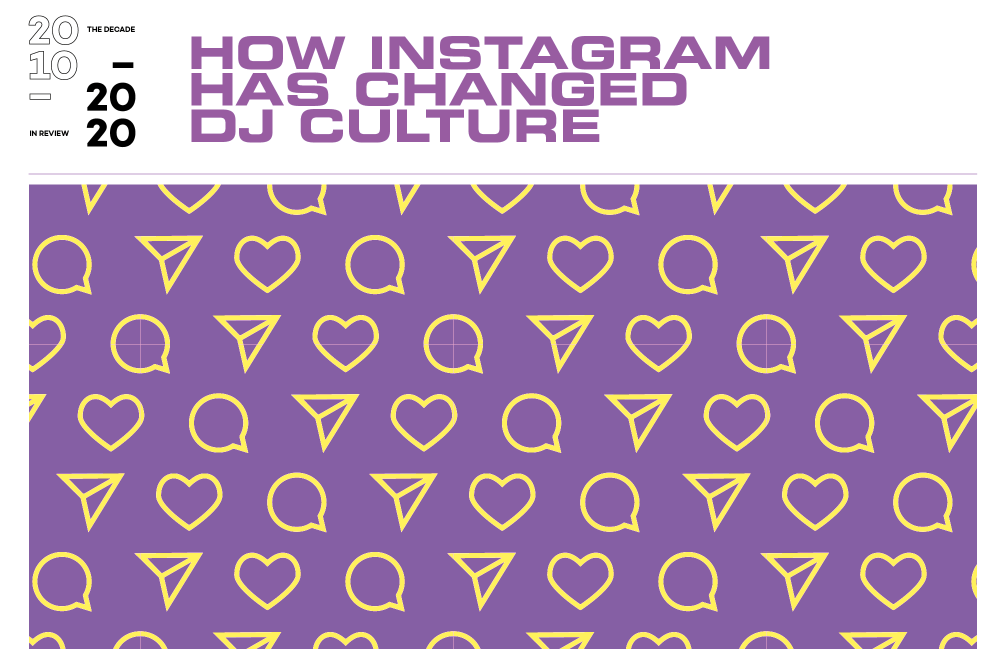 Features
Features
Work camera flash: how instagram has changed DJ culture
Since launching in 2010, Instagram has had a disruptive impact on dance music
The 2010s are almost over. In case you somehow missed it amidst the engorged list season and reflective long reads akin to this. With them we leave behind various post-post-future-post genres, ironic-not-ironic fashion trends and hopefullya Tory government.
A deluge of launches, innovations and cultural revolutions have emerged this decade, including Instagram, which popped up in late 2010 and has spent the ensuing nine years warping society in a multitude of ways. Our newfangled ‘I Gram Therefore I Am’ motto has led to the birth of influencers, meme accounts and URL stan fandoms from culture hotspots and, more excitingly, remote locations. Plus, an onslaught of multi-hyphenate artists with reaches that now span spaces far wider than just their local town or city. Much to the delight of brands, naturally.
Read this next: DM for Beats: 15 of the best producers on Instagram
Instagram has grown to become a lucrative tool for money-making means across the creative industries. These days, DJs and producers can essentially market, PR and create editorial content all via their phones without the need to outsource to other companies or even publications. Career boosts from a packed tour calendar to more press coverage to wider audiences are available to them if they navigate the platform with what would be deemed a ‘successful’ approach. To some it comes naturally, for others it’s the result of wily planning, driven by an increasing acceptance that it isn’t just music that does the talking.
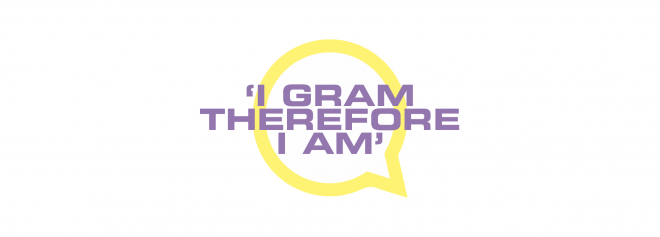
Take the rise and rise of Peggy Gou, for example. Be it playing to crowds of adoring, shoe-waving fans, designing clothes either collaboratively or for her label Kirin, kicking back wearing designer looks in selfies or front row at fashion week, she’s curated her feed to portray Peggy Gou™ the brand in order to offer desirable content and aspirational appeal for both her fans and the brands she chooses to work with. In October 2018 Peggy teamed up with Instagram for a behind the scenes style video, hosted on the platform’s official feed and filmed in Amsterdam during ADE in a move that highlights her interest to do more and share more via the platform in a wider content creation capacity.
For DJs on the rise, the platform and the brands that prioritise Instagram can help further their careers thanks to social media’s viral potential, which allows both the artists and their posts to be quickly shared and viewed on a global scale in relatively short periods of time.
Read this next: I'm addicted to watching archive rave footage on the internet
But by projecting the inside of the club to the world, an inverse effect is happening with some DJs adapting sets to appeal beyond the dancefloor. Subtlety doesn’t make for a snippet likely to gain much traction, so doling out bangers to appeal to videographers as well as the crowd is a cynical route to rising up the algorithm.
That’s not to say these viral moments are always forced, and there’s been many positive outcomes arising from clips of killer DJs wholeheartedly letting loose. Samrai, co-founder of Manchester label and club night Swing Ting, offered his take. He suggests that while there can be some pressure to create them, they can – and have – birthed the careers of some great acts, calling them “a mix of both forcing and positive discovery.”
“Plus, it's cool to be able to see footage from sets that you maybe didn't see previously from round the world. It [also] means that gatekeepers have to take notice of a DJ or promotion that's doing their thing regardless. For example, an amazing DJ doesn't just remain a local secret anymore.”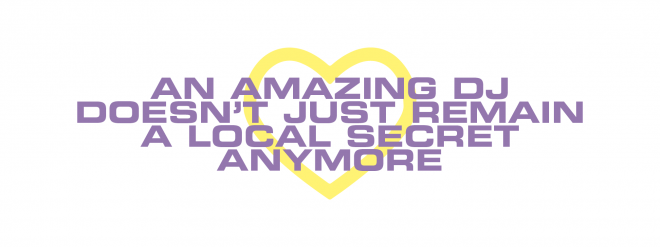
Former Mixmager, Hoover Sounds co-founder and certified international star SHERELLE is one those amazing DJs, who blew up at the beginning of the year thanks to the viral success of a Boiler Room stream revealing her talents behind the decks to a massive audience. She’s since signed to an agency and played high profile gigs across Europe and the US, and drawn attention from the likes of Virgil Abloh who clocked the posts circulating on social media and reached out. And SHERELLE’s Hoover Sounds cohort NAINA is another name utilising the platform to both document career moments while also being, you know, social.
Since her career kicked off, she’s used her Instagram as a blog or portfolio of sorts, to document career moments or projects she’s proud of. “It's a good form of self-promotion,” she says. “If you want to see what someone is up too, like, ‘Where is NAINA playing next?’, ‘Who's on her next radio show?’, or ‘What's being released on her label?’, you know that DJ or artist is most likely using Instagram to promote it.”
It’s a sentiment that Bang Face Weekender founder James St Acid agrees with. “[Instagram’s] almost fully replaced the old forms of promo like flyers, posters and the forums,” he says. “The aim is still the same – to spread the word organically. Social media generally works well for music events because people plan most of their social time there.”If a mash-up of memes, throwback, nostalgia-inducing rave shots and colourful promotional videos are your jam, look no further than Bang Face’s profile. The festival’s grid is filled with a smartly curated, wholly on brand series of images, short-film videos and pool party posts. “All these elements have always formed part of a Bang Face event: themed artwork, images, text banners, fancy dress have been a signature thing at the parties as the emphasis has always been about having fun,” says St Acid.
Watch this next: We went to The UK's most INSANE festival
There’s a clear method to the madness, even in Bang Face’s case. “It all follows a logical pattern,” says St Acid. “Each event will begin with the line-up info, then the fancy-dress theme which can go in many directions, then you have the photos, videos and set recordings from the parties. It’s simply the timeline for each event.”
But it’s not for everyone and it shouldn’t have to be. You don’t need an article to tell you that, but it can act as a welcome reminder that - despite the pressures on artists and fans alike to engage and be engaging - remaining sane and stable is more important than keeping up with social trends. There are many who opt of the platform, and they’re doing just fine!
Take Munich-based producer Skee Mask who’s doing more than fine, I think we can all agree, receiving universal acclaim his latest album ‘Compro’, including placing in 2018’s best albums lists from Pitchfork, RA, FACT and our own. But even he sometimes feels the pressure. “Nowadays as an artist you only need to look around once and you see 99 per cent of the other producers or DJs using platforms like Insta,” he says, explaining that often this pressure is inflicted internally – “because it makes you think that it's necessary or important to succeed in the business.”
He cites artists like Helena Hauff as good examples of those who still cultivate huge fan bases and attract mass crowds despite their lack of online presence, admiring her focus on her craft and interests away from social media.
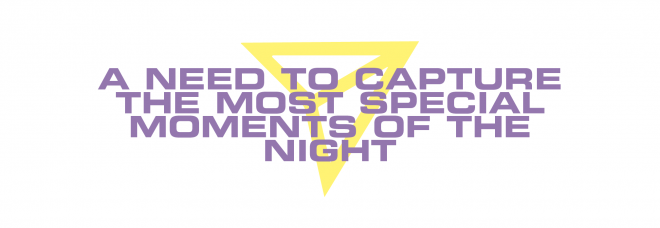
Elsewhere, the rise of the phones on the dancefloor debate might have become a sort of ‘old man shouts at cloud’ talking point, but it would be negligent to discuss the impact of social media on DJ culture without touching on its impact inside club spaces, too.
This transpire in various forms: from the dazzle of a camera flash interrupting your come up or intimate moment to a ‘rogue track’ culture, in which ‘Better Off Alone’ or something niche and 90s is shoehorned into a 4x4 set as if it’s a revolutionary selection, or a sea of phones held up high in place of flailing arms. It’s something venues can either embrace or push against. On the one hand, there’s the filmable aesthetics of Dekmantel’s kaleidoscopic main stage lighting, mega venues like Printworks or the rise of A/V shows. On the other, the no-phones policies of London spaces like Phonox or FOLD.
Read this next: 70 per cent of UK gig-goers are irritated by phones on the dancefloor
“A lot of the younger generation feel the need to capture the most special moments of the night through their phone to share on social media, which as a result actually means they aren't in that moment and miss it,” says Pretty Weirdfounder and DJ Barely Legal. “Ten years ago, Instagram or Snapchat weren't around so the only reason for people to be on their phones was to capture memories to have for themselves, to send to selected friends, or maybe share on Facebook. It seems people feel the need to let their followers know they were at the event seeing whatever DJ or artist for some reason, clout maybe?”
Phonox’s policy is an attempt to curb this behaviour on its dancefloor. “It isn't about trying to create Berghain levels of mystique around the venue, its simply to ensure that those on the dance floor are there to dance and enjoy the music without distraction,” says Ryan Phillips, Head of Music at The Columbo Group. “Implementing this rule brings the focus back to what really matters and that is being present in the moment and enjoying the music.”
Meanwhile Robbie Murch, who helms the mega ID-ing, dance music-hungry network and contemporary crate-digging resource that is The Identification of Music Group (IOM), adds: “I genuinely think it’s positive for clubs to have a no-phone policy. I think the older you get you sort of cherish privacy a bit more.”
Through his network and its contained footage of real festival and clubbing environments from eager party-goers, Robbie’s been able to spot various trends. A popular post on the group can elevate the profile of a track or artist, and one change he's noticed is an increase in managers and agents trying to game the group for personal gain. “People who want to sell records realise that it’s an asset,” he explains, “Sometimes you see artist’s teams being followed around by someone with a camera the whole time so all of their sets can be filmed and all of those moments can be dished out.”
But it’s not just a tool of capitalism. He adds: “Equally, IDs from real fans can be really important for smaller artists. Given everyone’s short attention span nowadays, posting clips of a high profile DJ playing your track has become, for better or worse, a key moment [for breaking artists], taking over from posting long-form articles where they get bigged up.”
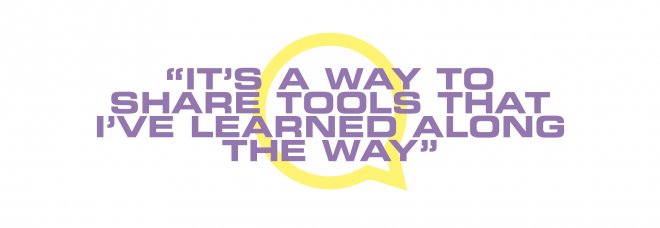
Vivie-Ann Bakos, formerly one half of Canadian techno duo Blond:ish (which she now helms solo) joined Instagram back in 2012. Back then she’d use it to post flyers, “boring promo” and didn’t yet see its potential. Eight years on, and with over 159,000 followers to boot, Instagram’s now her preferred place for chatting with fans, sharing her life, her music and other ventures such as her zero-plastic Bye Bye Plastic initiative. “I have a strong bond with my community, and they want to follow me because I’m authentic in anything I do,” she says. “Whether it’s my music, having a pizza party on the dancefloor, or trying to gather us all together to make some positive impact in this world through Bye Bye Plastic and honest discussions.”
Crowdfunding and other crowd-sourced, community-led ventures and initiatives have also found success after sharing appeals via social media. While they may not have started life on Instagram or Twitter, GoFundMe appeals for the likes of Epic B, who was robbed of his laptops and hard drive at gunpoint in January 2018, or Cooly G, who lost most of her and her children’s belongings in a storage unit fire late last year, were widely shared via socials in a bid to help support the artists in a way that simply wasn’t possible in decades past, with GoFundMe launching in 2010 much like Instagram. Elsewhere, London venues like The Cause, The Social and EartH all utilised crowdfunding sites and in turn social platforms to raise money to launch, prevent closure and make site transformations.
“I feel it’s my responsibility as a person with a platform and voice to use it in a positive way to continue to connect with the community all around the world, plant seeds and really make some impact together,” says Bakos on how artists can use social media for positive societal gain. “It’s a way to share tools that I’ve learned along the way, and also to learn and get inspired from each other.”
Artists aside, Instagram users expect a certain level of musical content from the platform, too –with IG users spending 42 per cent more on music-related items during a year compared to those who don’t, and 45,000,000 reactions to musician’s content on Instagram daily.
So, the demand is there, but does that mean artists need to supply? It’s been a topic discussed in depth across the latter half of the decade. Earlier this year Whitney Wei deep dove into those opting out of The Matrix and offered insight into why some aren’t quite so fortunate when it comes to not needing global reach and an online audience to succeed. Meanwhile, Sirin Kale took to Mixmag.net last year to explore another negative to the social media landscape – its impact on artists mental health with particular focus on comment sections, unwanted feedback and how these dangers magnify when it comes to DJs and producers from marginalised communities.
And more recently, Pioneer DJ released a new documentary titled INSTA DJ. It honed in on the mental health toll, success without socials and more, with the help of Annie Mac, Carl Cox, Ben Turner and more, arriving at an apt time with Instagram trialing the removal of likes in various countries of late. It’s a move that could suggest the platform is taking some sort of stance, whatever that may be, against the negative psychological effects that can stem from usage of the platform, while attempting to reduce some of these pressures for both music lovers, makers and just users in general. Or it could just be a crafty move on Instagram’s part to maximise ad revenues by reducing transparency for users.
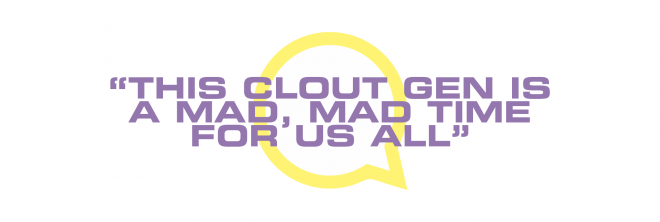
It goes without saying that Instagram will continue to play a part in the dance music world with or without visible likes well into the 2020s – well, at least until we all hop to the next platform and start this whole thing all over again – having been pivotal in the shift from disc jockey to brandable artist.
But despite its impact, social media does not have an unshakeable grip on dance music. Although there are obvious bonuses for those that navigate with care, and keep their mental health in check while engaging with platforms like Instagram, there are still successful artists who reject an online presence. The choice is yours.
“If I clock myself on social media too much, I call someone, or throw myself into editing, emails or DJing. We really need to clock how much time we're spending on social media and do something about it if we think it's affecting us mentally,” says NAINA on keeping sane on socials. “This clout gen is a mad, mad time for us all. Post your shit that you're proud about but don't watch the numbers. Remember, you're doing this for yourself, not for validation from others.”
Jasmine Kent-Smith is Mixmag's Staff Writer, follow her on Twitter


